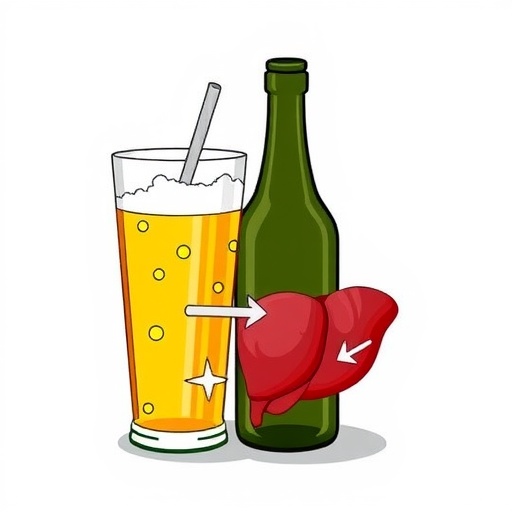In a groundbreaking study poised to redefine our understanding of alcohol-induced liver injury, researchers have identified a novel cellular mechanism linking binge drinking to severe hepatic inflammation. Published in Nature Communications, the study unravels how excessive alcohol consumption triggers a molecular cascade within Kupffer cells—specialized macrophages residing in the liver—leading to robust inflammatory responses. This research extends far beyond basic alcohol toxicity, pinpointing the involvement of VGLUT3-dependent glutamate secretion and the activation of the metabotropic glutamate receptor 5 (mGluR5) alongside NADPH oxidase 2 (NOX2) signaling pathways, shedding light on potential therapeutic targets for preventing liver disease in binge drinkers.
The liver is a vital organ responsible for detoxifying harmful substances, metabolizing drugs, and maintaining metabolic homeostasis. Yet, it remains highly susceptible to damage from excessive alcohol intake, a leading cause of progressive liver diseases including steatohepatitis, fibrosis, and cirrhosis. While the deleterious effects of chronic alcohol abuse have been extensively documented, binge drinking—characterized by episodic heavy alcohol intake—has emerged as a distinct risk factor for acute and chronic liver injury. The precise cellular and molecular underpinnings by which binge drinking inflicts liver damage have remained elusive, until now.
Central to the discovery is VGLUT3, or vesicular glutamate transporter 3, a protein traditionally recognized for loading glutamate—a principal excitatory neurotransmitter—into synaptic vesicles in the nervous system. Intriguingly, this transporter is also expressed in Kupffer cells, the liver’s resident immune sentinels. Under binge drinking conditions, VGLUT3 mediates glutamate secretion from Kupffer cells, creating a local surge in extracellular glutamate within hepatic tissue. This abnormal glutamate release acts as a signaling molecule, distinct from its classical role in neuronal communication.
.adsslot_3y0MZaObNC{ width:728px !important; height:90px !important; }
@media (max-width:1199px) { .adsslot_3y0MZaObNC{ width:468px !important; height:60px !important; } }
@media (max-width:767px) { .adsslot_3y0MZaObNC{ width:320px !important; height:50px !important; } }
ADVERTISEMENT
The researchers conducted meticulous in vivo and in vitro experiments demonstrating that binge alcohol exposure upregulates VGLUT3 expression in Kupffer cells. This upregulation accelerates glutamate secretion, which in turn activates mGluR5, a metabotropic glutamate receptor subtype known to modulate intracellular signaling cascades. Activation of mGluR5 on Kupffer cells instigates downstream signaling involving the NOX2 enzyme complex—a major enzymatic source of reactive oxygen species (ROS)—thereby amplifying oxidative stress and inflammatory cytokine production.
The amplification of oxidative stress through NOX2 enhances liver inflammation by recruiting additional immune cells and propagating a pro-inflammatory microenvironment. This vicious cycle contributes to liver tissue damage, evidenced by elevated markers of hepatic injury and histological signs of inflammation in the murine models studied. Notably, pharmacological blockade or genetic deletion of mGluR5 or NOX2 significantly mitigated glutamate-induced inflammatory responses, underscoring their critical roles as effectors in this pathway.
What sets this study apart is the identification of a glutamatergic signaling axis outside the central nervous system, highlighting a novel paradigm where neurotransmitter-like molecules serve as pivotal modulators of immune responses within the liver. This challenges the conventional compartmentalization between nervous system signaling and immune regulation, opening novel avenues for therapeutic development aimed at interrupting pathological glutamate signaling in hepatic diseases.
Beyond expanding fundamental biology, these findings bear profound clinical implications. Current approaches to treating alcohol-related liver disease largely focus on behavioral interventions or managing late-stage complications. With the newfound understanding of how binge drinking first triggers glutamate-mediated Kupffer cell activation, it becomes conceivable to design targeted therapies that intervene early in the disease process. For instance, specific antagonists of mGluR5 or inhibitors of NOX2 activity may serve as protective agents to curb hepatic inflammation resulting from episodic heavy drinking.
Moreover, the study spotlights VGLUT3 as a potential biomarker for alcohol-induced liver injury. Monitoring VGLUT3 levels or glutamate secretion in liver biopsies or circulating immune cells could provide early indicators of pathological changes before overt clinical symptoms manifest. Such diagnostic advancements could facilitate timely interventions to prevent progression to chronic liver disease in at-risk populations.
The research team employed a multifaceted methodological approach combining genetic mouse models, high-resolution imaging, molecular biology techniques, and biochemical assays. By utilizing VGLUT3 knockout mice, they confirmed the indispensable role of this transporter in mediating glutamate release following acute alcohol intoxication. Complementary pharmacological experiments further delineated the downstream signaling pathways, validating the mechanistic sequence from VGLUT3-mediated glutamate secretion to mGluR5/NOX2 activation and inflammatory gene expression.
An intriguing observation was the selective vulnerability of Kupffer cells to alcohol-induced glutamate signaling, while other hepatic cell populations remained less responsive. This cell-type specificity underscores the specialized immunoregulatory functions of Kupffer cells and aligns with their role as first responders to liver injury. The localized glutamate burst likely fine-tunes their activation threshold, transforming a neurochemical messenger into a critical immune modulator.
While this investigation focused on binge drinking models mimicking human episodic alcohol consumption, the researchers acknowledge that future studies are required to explore whether similar mechanisms operate in chronic alcoholism and other liver insults. Additionally, the interplay between glutamate signaling and other hepatic cell types such as hepatocytes, stellate cells, and infiltrating monocytes warrants further exploration to capture the full complexity of liver disease pathogenesis.
The authors also considered the implications of glutamate receptor signaling beyond inflammation, hypothesizing that such pathways might influence fibrogenesis or regenerative processes in the liver. Given that mGluR5 receptors are G protein-coupled receptors capable of modulating a variety of intracellular cascades, their involvement could extend to cellular proliferation and apoptosis, facets critical to liver repair and remodeling.
Importantly, this research redefines binge drinking from merely a behavioral risk factor to a biological orchestrator of molecular events driving liver pathology. It underscores the necessity for precision medicine approaches that integrate behavioral interventions with pharmacological blockade of identified molecular targets to effectively mitigate alcohol-induced hepatic damage.
In conclusion, the landmark findings reported by Yang, Kim, Ryu, and colleagues constitute a singular advance in our molecular understanding of alcohol-related liver inflammation. Harnessing the power of cutting-edge genetic and pharmacological tools, the study not only decodes a critical cellular mechanism but also offers a tangible blueprint for therapeutic innovation. Future translational efforts and clinical trials inspired by this work may revolutionize the management of alcohol-associated liver disease, transforming it from a silent epidemic to an effectively controlled condition.
Subject of Research: Mechanistic investigation of binge drinking-induced hepatic inflammation mediated by VGLUT3-dependent glutamate secretion and activation of mGluR5/NOX2 signaling in Kupffer cells.
Article Title: Binge drinking triggers VGLUT3-mediated glutamate secretion and subsequent hepatic inflammation by activating mGluR5/NOX2 in Kupffer cells.
Article References:
Yang, K., Kim, K., Ryu, T. et al. Binge drinking triggers VGLUT3-mediated glutamate secretion and subsequent hepatic inflammation by activating mGluR5/NOX2 in Kupffer cells. Nat Commun 16, 5546 (2025). https://doi.org/10.1038/s41467-025-60820-3
Image Credits: AI Generated
Tags: alcohol-induced liver diseasebinge drinking health risksbinge drinking liver inflammationglutamate secretion alcohol effectshepatic inflammation mechanismsliver detoxification processesmacrophages Kupffer cellsmetabotropic glutamate receptor 5NADPH oxidase 2 signalingprogressive liver diseasestherapeutic targets liver diseaseVGLUT3 pathway alcohol injury





